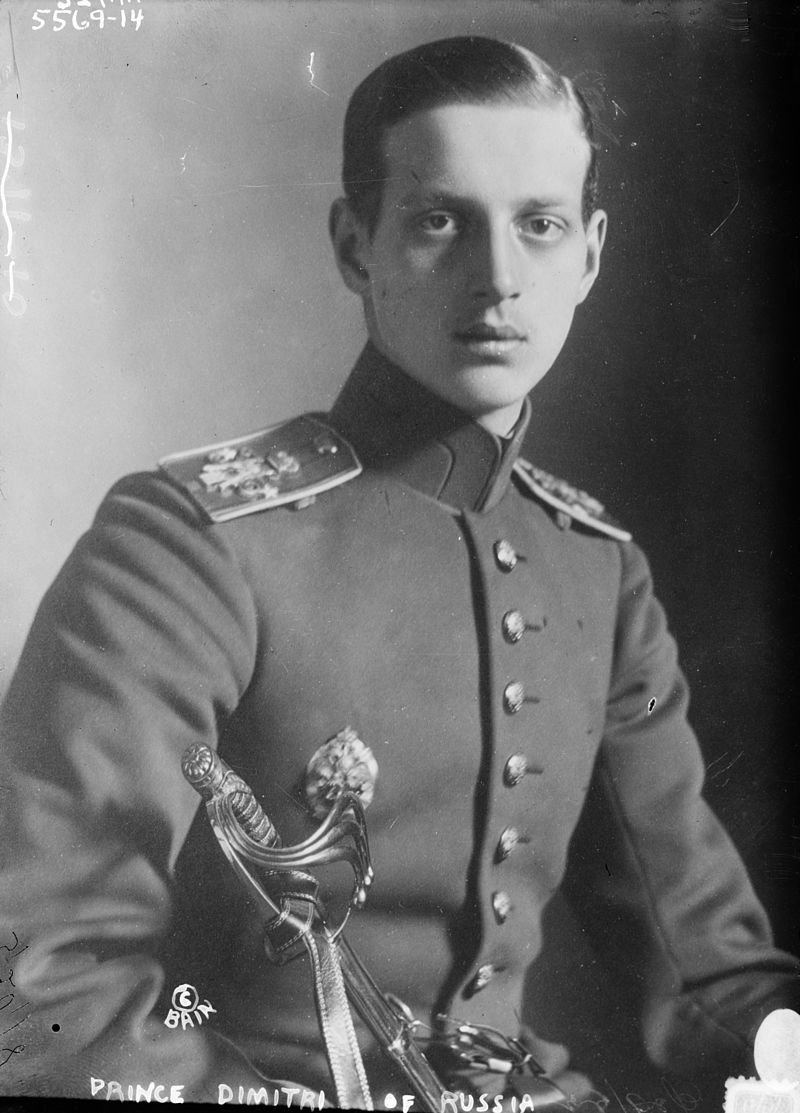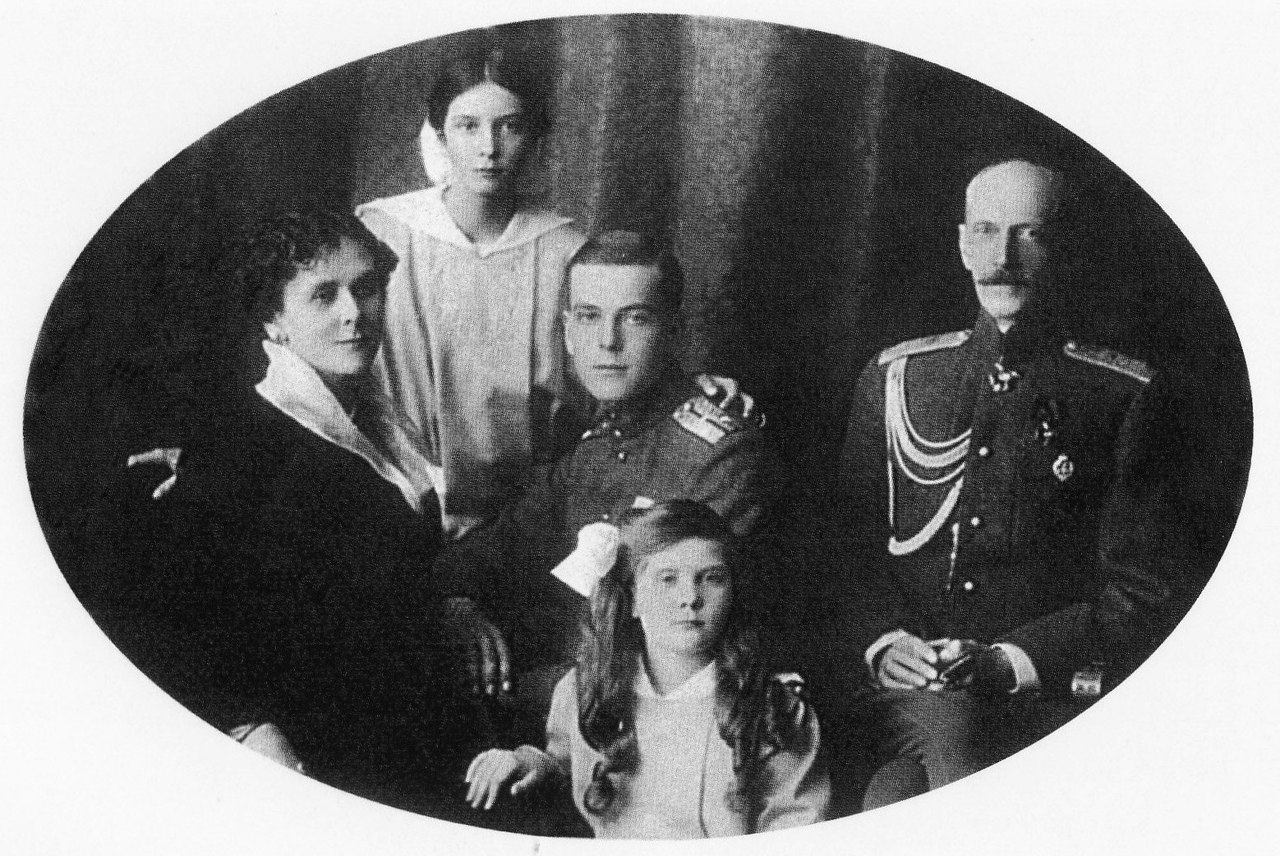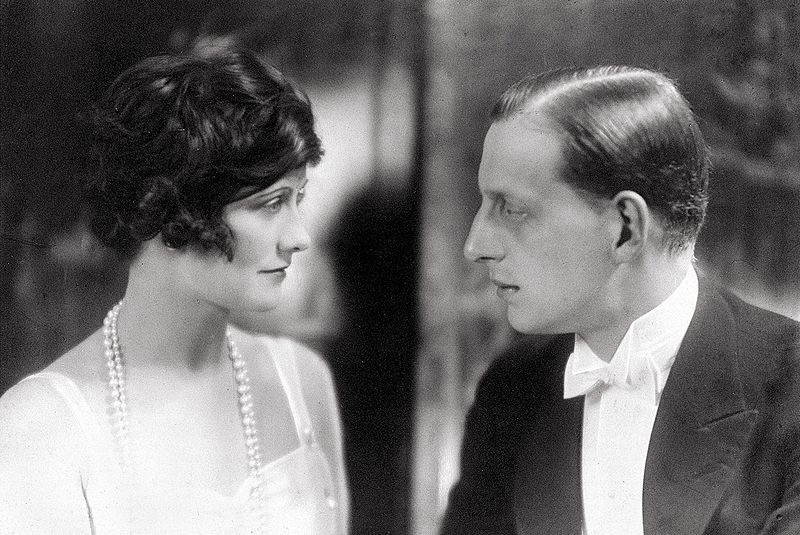by Susan Flantzer © Unofficial Royalty 2018

Grand Duke Dmitri Pavlovich of Russia; Credit – Wikipedia
Grand Duke Dmitri Pavlovich of Russia was one of the conspirators in the murder of Grigori Yefimovich Rasputin and also the first cousin of both Nicholas II, the last Emperor of All Russia and Prince Philip, Duke of Edinburgh. He was born on September 18, 1891, at Ilyinskoye, the country estate outside of Moscow of his paternal uncle Grand Duke Sergei Alexandrovich of Russia.
Dmitri was the only son and the second of the two children of Grand Duke Paul Alexandrovich of Russia and Princess Alexandra of Greece and Denmark (Grand Duchess Alexandra Georgievna). Grand Duke Paul was the youngest child of Alexander II, Emperor of All Russia and Princess Marie of Hesse and by Rhine (Empress Maria Alexandrovna). Princess Alexandra was the eldest daughter of King George I of Greece (born Prince Vilhelm of Denmark) and Grand Duchess Olga Konstantinovna of Russia, a granddaughter of Nicholas I, Emperor of All Russia.

Grand Duke Dmitri’s parents at the time of their engagement; Credit – Wikipedia
Dmitri’s parents were visiting Grand Duke Sergei and his wife Grand Duchess Elizabeth Feodorovna (born Elizabeth of Hesse and by Rhine). His mother Alexandra, who was seven months pregnant with her second child, took a walk with her friends, jumped into a boat and fell. The next day, she collapsed from violent labor pains in the middle of a ball. Alexandra gave birth prematurely to Grand Duke Dmitri Pavlovich and then she lapsed into a coma. She did not recover consciousness and died six days later on September 24, 1891, at the age of 21. Alexandra probably died from eclampsia, a condition that causes a pregnant woman, usually previously diagnosed with preeclampsia (high blood pressure and protein in the urine), to develop seizures or coma.
Born two months premature, Dmitri was not expected to live. It was through the efforts of his uncle Grand Duke Sergei that Dmitri survived. Sergei gave his nephew warm baths and wrapped him in cotton blankets in a cradle filled with hot water bottles. Dmitri’s father Grand Duke Paul was grief-stricken and depressed after the tragic death of his wife. For a period of time, his childless brother Grand Duke Sergei and his wife Grand Duchess Elizabeth took care of Dmitri and his seventeen-month-old sister Maria Pavlovna:
- Grand Duchess Maria Pavlovna (1890 – 1858), married (1) Prince Wilhelm of Sweden, Duke of Södermanland, had one son, divorced (2) Prince Sergei Mikhailovich Putyatin, had one son who died in infancy, divorced

Grand Duke Sergei, Grand Duchess Elizabeth with Grand Duchess Maria and Grand Duke Paul with Grand Duke Dmitri; Credit – Wikipedia
Dmitri Pavlovich was well-connected to royalty throughout Europe. Among his other first cousins were King Christian X of Denmark, King Haakon VII of Norway, King George V of the United Kingdom, Queen Maud of Norway, King Constantine I of Greece, Queen Marie of Romania and Grand Duchess Victoria Feodorovna (Princess Victoria Melita of Edinburgh and Saxe-Coburg and Gotha) who married Grand Duke Kirill Vladimirovich of Russia, who was both Dmitri’s first cousin and his wife’s first cousin.
Eventually, Grand Duke Paul recovered from his grief and Maria and Dmitri went to live with him in St. Petersburg where the two children were brought up by English nannies. Christmas holidays and some periods during the summer were spent with their uncle and aunt, Grand Duke Sergei and Grand Duchess Elizabeth Feodorovna.
In 1895, Dmitri’s father, Grand Duke Paul, began an affair with a married woman, Olga Valerianovna Karnovich. Olga gave birth in 1897 to a son. After Olga divorced her husband, Paul asked for permission to marry her from his nephew Nicholas II, Emperor of All Russia but Nicholas refused. Despite this, Paul morganatically married Olga in 1902. Because he married without Nicholas II’s permission, Paul was banished from Russia, dismissed from his military commissions, and his property was seized. His brother Grand Duke Sergei was appointed the guardian of Maria and Dmitri. Grand Duke Paul and his wife Olga settled in France. He was periodically allowed to visit his children in Russia. Grand Duke Paul was allowed to return to Russia for good in 1914. His titles and property were restored and Nicholas II granted his wife and children the titles Princess/Prince Paley.
Grand Duke Paul had three children with Olga, Dmitri’s half-siblings:
- Prince Vladimir Pavlovich Paley (1897–1918), one of the five Romanovs executed on July 18, 1918, along with Grand Duchess Elizabeth Feodorovna
- Princess Irina Pavlovna Paley (1903–1990), married (1) Prince Feodor Alexandrovich of Russia, had one son, divorced (2) Count Hubert Conquere de Monbrison, had one daughter
- Princess Natalia Pavlovna Paley (1905–1981), married (1) Lucien Lelong, a French fashion designer, no children (2) John Chapman Wilson, an American theatre director and producer, no children

Grand Duke Paul with his second wife Olga, and their children in 1916; Credit – Wikipedia
Since the children’s guardian Grand Duke Sergei Alexandrovich was the Governor-General of Moscow, Dmitri and his sister Maria lived with their aunt and uncle at the Nicholas Palace in the Moscow Kremlin and Ilyinskoye, Sergei’s country estate. When Grand Duke Sergei was assassinated by a bomb in 1905, his brother Paul was allowed to return to Russia to attend the funeral. He asked Nicholas II to restore the custody of his children but instead, Nicholas named Sergei’s widow Grand Duchess Elizabeth Feodorovna as the children’s guardian.

Dmitri and his sister Maria Pavlovna with their uncle and guardian Grand Duke Sergei Alexandrovich; Credit – Wikipedia
Until he was ready to go to military school and his sister married, Dmitri, along with his sister Maria, continued living with Grand Duchess Elizabeth at the Nicholas Palace in the Moscow Kremlin and the country estate Ilyinskoye. In 1907, Dmitri’s sister Maria Pavlovna became engaged to Prince Wilhelm, Duke of Södermanland, the second son of King Gustav V of Sweden. They were married at the Catherine Palace at Tsarskoye Selo on May 3, 1908, and then Maria was off to a new life in Sweden. The marriage was unhappy and in 1913, Maria left her husband and son and returned to Russia, causing a great scandal in Sweden. On March 13, 1914, her marriage was officially dissolved.
In 1909, Dmitri went to St. Petersburg accompanied by his tutor, where he was enrolled in the Nikolaevskoe Cavalry School to prepare for a military career in the Life Guards Horse Regiment. In St. Petersburg, Dmitri first lived in his father’s vacant palace and then in the Belosselsky-Belozersky Palace, formerly owned by Grand Duke Sergei. Sergei’s widow Grand Duchess Elizabeth sold all her jewelry and with the proceeds opened the Convent of Saints Martha and Mary. She became its abbess and gave the ownership of the Belosselsky-Belozersky Palace to Dmitri.

Dmitri in 1910; Credit – Wikipedia
Grand Duke Dmitri participated in the 1912 Olympics in Stockholm in the Equestrian Individual and Team Jumping events. He placed ninth in Individual Jumping and fifth in Team Jumping. Disappointed in the Russian team’s performance, Dmitri started the idea of a national Russian sports competition, the very beginning of what under Soviet rule became the Spartakiad.

Grand Duke Dmitri Pavlovich competing in the 1912 Stockholm Olympics; Credit – Wikipedia
During World War I, Dmitri served with the Life Guards Horse Regiment, participated in the campaign in East Prussia, and was awarded the Order of St. George. During the war, a situation with Dmitri’s first cousin Nicholas II, and his family caused Dmitri to take action.
In the fall of 1916, the Romanov family was increasingly worried about Grigori Rasputin’s influence on Nicholas II, Emperor of All Russia and his wife Empress Alexandra Feodorovna. After working with many physicians to help her son Tsarevich Alexei relieve his hemophilia, Alexandra turned to mystics and faith healers. This led to her close, and politically dangerous, relationship with Grigori Rasputin. Several times Rasputin appeared to have brought the Tsarevich back from the brink of death, further cementing Alexandra’s reliance. Rasputin became an influential figure in Saint Petersburg, especially after August 1915, when Nicholas II took supreme command of the Russian armies fighting in World War I. Eventually, a group of conspirators plotted to murder Rasputin hoping to end his influence over the Imperial Family.

Rasputin with Empress Alexandra Feodorovna, her children and their governess; Credit – Wikipedia
Grand Duke Dmitri Pavlovich was one of the conspirators along with Prince Felix Felixovich Yusupov, a Russian aristocrat, wealthier than any Romanov. Felix married Princess Irina Alexandrovna of Russia, Nicholas II’s only niece, the daughter of his sister Grand Duchess Xenia Alexandrovna and Grand Duke Alexander Mikhailovich of Russia.
Along with Dmitri and Felix, Vladimir Purishkevich, a deputy of the Duma, the Russian legislature, was one of the main conspirators. Other participants were Dr. Stanislaus de Lazovert, a physician, and Sergei Mikhailovich Sukhotin, a lieutenant in the Preobrazhensky Regiment. On the night of December 29-30, 1916, Felix invited Rasputin to Moika Palace, his home in St. Petersburg, promising Rasputin that his wife Irina would be there, although she was not there.

Basement in the Moika Palace where Rasputin was murdered; Credit – Wikipedia
According to his memoir, Felix brought Rasputin to a soundproof room in a part of the wine cellar and offered Rasputin tea and petit fours laced with a large amount of cyanide, but the poison had no effect. Felix then offered Rasputin wine, and after an hour Rasputin was fairly drunk. The other conspirators were waiting in a room on another floor of the palace and Felix went upstairs and returned with Dmitri’s revolver. Felix shot Rasputin in the chest and the wounds appeared to be serious enough to cause death. However, Rasputin escaped, struggling up the stairs and opening an unlocked door to the courtyard. Purishkevich heard the noise, went out to the courtyard, and shot Rasputin four times, missing three times. Rasputin fell down in the snow. Again, Rasputin should have been dead, but he was still moving. One of the conspirators shot him in the forehead. Rasputin’s body was thrown off the Bolshoy Petrovsky Bridge into an ice hole in the Malaya Neva River. Rasputin’s body was found a few days later.
After Rasputin’s murder, the St. Petersburg authorities refused to arrest the conspirators because the murder they committed was considered acceptable. Instead, Dmitri was exiled to Persia (now Iran), a move that most likely saved his life during the Russian Revolution. Felix was exiled to his estate in Rakitnoje, near Belgorod, Russia, and the Ukraine border.
The Russian Revolution was disastrous to Dmitri Pavlovich’s family. Prince Vladimir Paley, Dmitri’s half-brother was arrested in St. Petersburg on March 26, 1918, along with three sons of Grand Duke Konstantin Konstantinovich, a grandson of Nicholas I: Prince Ioann, Prince Konstantin, and Prince Igor. On July 18, 1918, the day after the execution of Nicholas II, Emperor of All Russia and his family, Dmitri’s half-brother Prince Vladimir Paley, Prince Ioann, Prince Konstantin, Prince Igor, Grand Duke Sergei Mikhailovich, and Grand Duchess Elizabeth Feodorovna, Dmitri’s aunt and his former guardian, were murdered by the Bolsheviks. See Unofficial Royalty: Execution of Grand Duchess Elizabeth Feodorovna and Five Other Romanovs for more information.

Grand Duke Dmitri with his father Grand Duke Paul and his sister Grand Duchess Maria in 1914; Credit – Wikipedia
Dmitri’s father Grand Duke Paul Alexandrovich was arrested on August 13, 1918. On January 28, 1919, Grand Duke Paul Alexandrovich, along with three other Grand Dukes, was executed by a firing squad in the courtyard of the Peter and Paul Fortress. See Unofficial Royalty: Execution of Four Russian Grand Dukes for more information.
In exile in Persia (now Iran), Dmitri served briefly with General Nikolai Nikolaevich Baratov who headed the 1st Caucasus Cossack Corps on the Caucasus Front. However, after the February 1917 Revolution, resulting in the abdication of Nicholas II, the end of the Romanov dynasty, and the end of the Russian Empire, General Baratov could no longer guarantee that Dmitri would be safe among the Russian troops. In 1918, Sir Charles Murray Marling, a British diplomat, persuaded the British Foreign Office that Dmitri could be the next Emperor of Russia and helped Dmitri to gain admission into the United Kingdom where he lived for two years.

Coco Chanel and Grand Duke Dmitri; Photo Credit – Wikipedia
Dmitri’s sister Maria Pavlovna had escaped Russia and settled in Paris, France. Like many exiled aristocratic Russians, Maria found a place for herself in the Paris fashion industry by starting a Russian embroidery shop called “Kitmir” that specialized in embroidery with beads and sequins. Her brother Dmitri made his way to Paris and the two siblings were reunited. Dmitri began a love affair with the fashion designer Coco Chanel. This proved to be a great advantage to Maria’s business and soon Chanel became Maria’s main client.

Audrey Emery and Grand Duke Dmitri Pavlovich on their wedding day; Credit – Wikipedia
On November 21, 1926, in the Russian Orthodox Church in Biarritz, France, Dmitri married the rich American heiress Audrey Emery. Audrey, born in Cincinnati, Ohio, was the youngest daughter of John Josiah Emery, a real-estate millionaire. Since this marriage did not comply with the rules of the House of Romanov, Dmitri’s cousin Grand Duke Kirill Vladimirovich, head of the Romanov family, gave Audrey and any children from the marriage the princely title Romanovsky-Ilyinsky. The couple lived in Europe, where Dmitri participated in various Russian monarchist and patriotic movements and had a significant role in the creation of the Union of Mladoross (Union of Young Russia). Dmitri and Audrey divorced in 1937.
Dmitri and Audrey had one son, named after Dmitri’s father Grand Duke Paul Alexandrovich:
- Prince Paul Dmitriievich Romanovsky-Ilyinsky, later known as Paul Ilyinsky (1928 – 2004), married (1) Mary Evelyn Prince, no children (2) Angelica Philippa Kauffmann, had four children

Grand Duke Dmitri with his son and wife; Credit – Wikipedia
Dmitri’s son Paul was an American and a British citizen. He was born on January 27, 1928, in the Embassy of the United States in London, England, United Kingdom. After his parents divorced, Paul lived with his mother. He attended the Woodberry Forest School in Virginia and the Royal Military Academy Sandhurst in England and graduated from the University of Virginia. During the Korean War, Paul served in the United States Marine Corps as a combat war photographer. After the Korean War, Paul served for about twenty years on the board of Emery Industries, his mother’s family company. In 1980, Paul moved to Palm Beach, Florida where he served three terms as Mayor of Palm Beach. Paul Ilyinsky died at his Palm Beach home on February 10, 2004, at the age of 76. Paul’s youngest son Michael was active with the Romanov Family Association.
After his divorce, Dmitri lived at the Château de Beaumesnil in Beaumesnil, Eure, France, which he had bought in 1927. Over the years, Dmitri became disappointed with the prospects of the monarchy’s restoration in Russia and withdrew from public life. He lived at the Château de Beaumesnil until 1938 when, due to the deterioration of his health, Dmitri sold the château to Jewish financier and bibliophile Hans Fürstenberg, a refugee from Nazi Germany. In 1982, when Fürstenberg died, the chateau was left to a foundation entrusted to conserve the property and Fürstenbergs library.

Chateau de Beaumesnil; Photo Credit – CC BY-SA 3.0, https://commons.wikimedia.org/w/index.php?curid=1055782
It is believed that Dmitri’s ill health was caused by tuberculosis. His doctors estimated that he first contracted tuberculosis around 1929. In 1939, Dmitri entered Schatzalp Sanatorium in Davos, Switzerland and he died there on March 5, 1942, at the age of 50. Because the sanatorium’s medical records were destroyed when the sanatorium was converted into a hotel in the 1950s, there is no definite cause for Dmitri’s death. Both tuberculosis and uremia have been cited.
Grand Duke Dmitri Pavlovich was initially buried at Waldfriedhof, a cemetery in Davos, Switzerland. In the late 1950s, his remains were transferred to the Mainau Palace Church, on Mainau Island in Lake Constance, Germany, on the estate of Count Lennart Bernadotte of Wisborg, his nephew, the only child of his sister Maria Pavlovna. There Dmitri Pavlovich and Maria Pavlovna rest in peace next to each other.

Dmitri’s burial place in the Mainau Palace Church; Credit – www.findagrave.com
This article is the intellectual property of Unofficial Royalty and is NOT TO BE COPIED, EDITED, OR POSTED IN ANY FORM ON ANOTHER WEBSITE under any circumstances. It is permissible to use a link that directs to Unofficial Royalty.
Works Cited
- De.wikipedia.org. (2018). Dmitri Pawlowitsch Romanow. [online] Available at: https://de.wikipedia.org/wiki/Dmitri_Pawlowitsch_Romanow [Accessed 10 Mar. 2018].
- En.wikipedia.org. (2018). Grand Duke Dmitri Pavlovich of Russia. [online] Available at: https://en.wikipedia.org/wiki/Grand_Duke_Dmitri_Pavlovich_of_Russia [Accessed 10 Mar. 2018].
- Fr.wikipedia.org. (2018). Dimitri Pavlovitch de Russie. [online] Available at: https://fr.wikipedia.org/wiki/Dimitri_Pavlovitch_de_Russie [Accessed 10 Mar. 2018].
- Manger, H. (1998). Elizabeth, Grand Duchess of Russia. New York: Carroll & Graf Publishers, Inc.
- https://ru.wikipedia.org/wiki/%D0%94%D0%BC%D0%B8%D1%82%D1%80%D0%B8%D0%B9_%D0%9F%D0%B0%D0%B2%D0%BB%D0%BE%D0%B2%D0%B8%D1%87
- Unofficial Royalty. (2018). Murder of Grigori Yefimovich Rasputin. [online] Available at: https://www.unofficialroyalty.com/murder-of-grigori-yefimovich-rasputin/ [Accessed 10 Mar. 2018].
- Warwick, C. (2006). Princess, Saint and Martyr. Chichester: Wiley.
